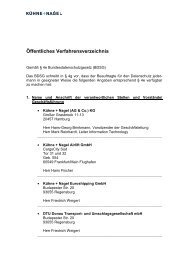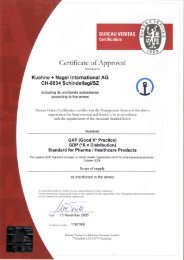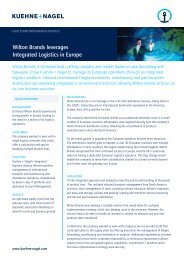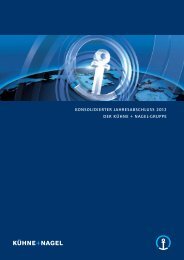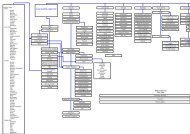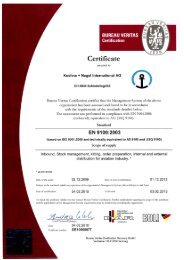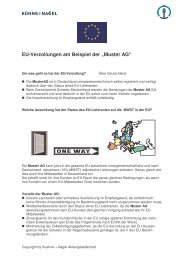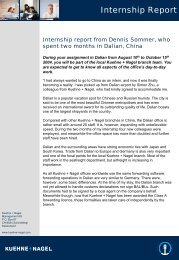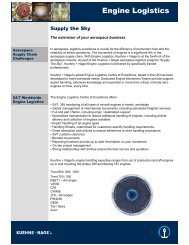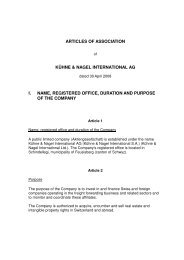ANNUAL REPORT 2011 - Kuehne + Nagel
ANNUAL REPORT 2011 - Kuehne + Nagel
ANNUAL REPORT 2011 - Kuehne + Nagel
You also want an ePaper? Increase the reach of your titles
YUMPU automatically turns print PDFs into web optimized ePapers that Google loves.
6 Financial assets and liabilities<br />
The accounting policy applied to financial instruments depends<br />
on how they are classified. The Group’s financial assets and liabilities<br />
are classified into the following categories:<br />
— The category financial assets or liabilities at fair value<br />
through profit or loss includes financial assets or liabilities<br />
held for trading and financial assets designated as such upon<br />
initial recognition. There are no financial liabilities that, upon<br />
initial recognition, have been designated at fair value through<br />
profit or loss.<br />
— Loans and receivables are carried at amortised cost, calculated<br />
using the effective interest rate method, less allowances<br />
for impairment.<br />
— Financial assets/investments available for sale include all<br />
financial assets/investments not assigned to one of the above<br />
mentioned categories. These could include investments in affiliates<br />
that are not associates or joint ventures and investments<br />
in bonds and notes. Financial assets/investments available for<br />
sale are recognised at fair value, changes in value (after tax) are<br />
recognised directly in other comprehensive income until the<br />
assets are sold, at which time the amount reported in other<br />
comprehensive income is transferred to the income statement.<br />
As of December 31, <strong>2011</strong> and 2010, the Group did not have<br />
any financial assets/investments available for sale.<br />
— Financial liabilities that are not at fair value through profit<br />
or loss, are carried at amortised cost calculated using the<br />
effective interest rate method.<br />
Derivatives and hedge accounting<br />
Derivative financial instruments (foreign exchange contracts)<br />
are used to hedge the foreign exchange exposures on outstanding<br />
balances in the Group's internal clearing system, centralised<br />
at head office. Given that the Group's hedging activities are limited<br />
to hedges of recognised foreign currency monetary items,<br />
the Group does not apply hedge accounting under IAS 39.<br />
Derivatives are carried at fair value, and all changes in fair<br />
value are recognised immediately in the income statement as<br />
part of financial income or expenses. All derivatives with a positive<br />
fair value are disclosed as derivative assets and included in<br />
the line “financial investments” on the balance sheet, while all<br />
derivatives with a negative fair value are disclosed as derivative<br />
liabilities and included in the line current “other liabilities”.<br />
Consolidated Financial Statements <strong>2011</strong> _ _ _ _ _ _ Accounting Policies<br />
Impairment of financial assets<br />
If there is any indication that a financial asset (loans and receivables)<br />
or financial assets/investments available for sale may be<br />
impaired, its recoverable amount is calculated. The recoverable<br />
amount of the Group’s loans and receivables is calculated as the<br />
present value of expected future cash flows, discounted at the<br />
original effective interest rate inherent in the asset. Receivables<br />
with a short duration are not discounted.<br />
Trade receivables are reported at their anticipated recoverable<br />
amounts. The allowance for bad debts is determined based on<br />
an individual basis or on a portfolio basis, where there is objective<br />
evidence that impairment losses have been incurred. The<br />
allowance account is used to record impairment losses unless<br />
the Group is satisfied that no recovery of the amount due is<br />
possible; at that point the amount considered irrecoverable is<br />
written off against the financial assets directly.<br />
Where an asset’s recoverable amount is less than its carrying<br />
amount, the asset is written down to its recoverable amount. All<br />
resultant impairment losses (after reversing previous revaluations<br />
recognised in other comprehensive income of available for<br />
sale equity securities) are recognised in the income statement.<br />
An impairment loss in respect of a financial asset is reversed if<br />
there is a subsequent increase in recoverable amount that can<br />
be related objectively to an event occurring after the impairment<br />
loss was recognised. Reversals of impairment losses are<br />
recognised in the income statement, with the exception for<br />
reversals of impairment losses on available for sale equity securities,<br />
for which any reversals are recognised in other comprehensive<br />
income.<br />
7 Segment reporting<br />
An operating segment is a component of the Group that engages<br />
in business activities from which it may earn revenues and incur<br />
expenses, including revenues and expenses that relate to transactions<br />
with any of the Group’s other components. Refer to note 20<br />
for additional information about the segments in the Group.<br />
65





